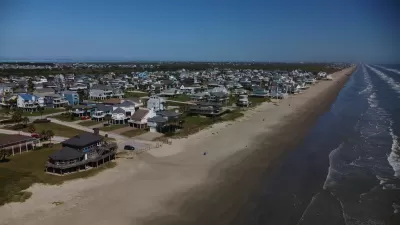Many experts believe that a property crash, as a result of Hurricanes or sea level rise, on the coast of South Florida is inevitable. But that hasn't deterred the suppliers or the consumers in the Miami real estate market.

A longform article by Nathalie Baptiste asks a big question of Florida's second-most populated city: "Why is Miami—America’s most vulnerable metropolis to sea-level rise—having yet another beachfront development boom?"
Baptiste begins by noting the current growth trend in the local development market: "The previous boom halted briefly after the 2008 collapse, but by 2011 it was on again. As of June 2015, more than 355 new towers have been proposed in South Florida." But the current optimism comes with great risk, which both consumers and suppliers seem completely blind to—whether willfully or not. Baptiste includes many pithy paragraphs to make this point, including the following:
The great cliche of the real estate business is that location is everything. That’s especially the case with buildings vulnerable to climate change. A truly green building is structurally sound, energy-efficient, low-cost, and in an area that isn’t vulnerable to sea-level rise and climate-change impacts. So a green building in a bad place is a bad building. In a place like greater Miami, the problem is both too many buildings in the wrong places, and standards that aren’t stringent enough.
Despite the billions of dollars in spending and years of planning it will take to prepare the Miami area for the effects of climate change is almost the opposite of what's happening in Miami, according to the story told in this article. Instead of planning and building safety measures, Miami is subsidizing flood insurance and incentivizing developers in risky areas.
FULL STORY: That Sinking Feeling

Planetizen Federal Action Tracker
A weekly monitor of how Trump’s orders and actions are impacting planners and planning in America.

Congressman Proposes Bill to Rename DC Metro “Trump Train”
The Make Autorail Great Again Act would withhold federal funding to the system until the Washington Metropolitan Area Transit Authority (WMATA), rebrands as the Washington Metropolitan Authority for Greater Access (WMAGA).

The Simple Legislative Tool Transforming Vacant Downtowns
In California, Michigan and Georgia, an easy win is bringing dollars — and delight — back to city centers.

The States Losing Rural Delivery Rooms at an Alarming Pace
In some states, as few as 9% of rural hospitals still deliver babies. As a result, rising pre-term births, no adequate pre-term care and "harrowing" close calls are a growing reality.

The Small South Asian Republic Going all in on EVs
Thanks to one simple policy change less than five years ago, 65% of new cars in this Himalayan country are now electric.

DC Backpedals on Bike Lane Protection, Swaps Barriers for Paint
Citing aesthetic concerns, the city is removing the concrete barriers and flexposts that once separated Arizona Avenue cyclists from motor vehicles.
Urban Design for Planners 1: Software Tools
This six-course series explores essential urban design concepts using open source software and equips planners with the tools they need to participate fully in the urban design process.
Planning for Universal Design
Learn the tools for implementing Universal Design in planning regulations.
Smith Gee Studio
City of Charlotte
City of Camden Redevelopment Agency
City of Astoria
Transportation Research & Education Center (TREC) at Portland State University
US High Speed Rail Association
City of Camden Redevelopment Agency
Municipality of Princeton (NJ)





























